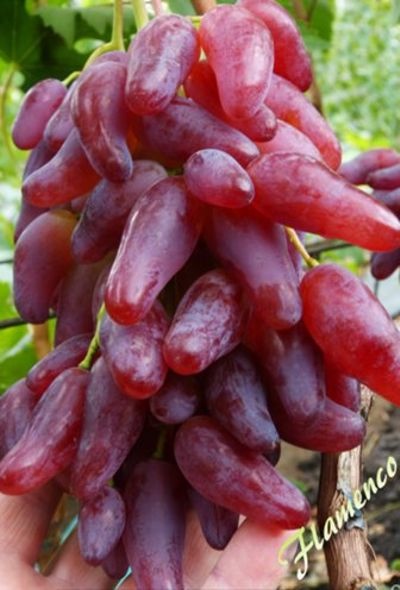
- Authors: Andrey Karpushev, Zaporozhye, Ukraine
- Appointment: dining room
- Berry color: bright red or crimson
- Taste: harmonious
- Ripening period: average
- Bunch weight, g: 600
- Flower type: bisexual
- Density of the bunch: moderate
- Skin: thin, hardly felt when eaten
- Appeared when crossing: Soffit x Kishmish Radiant
Flamenco is a table variety of grapes. The newest hybrid appeared in 2015. Medium early in terms of ripening, with high productivity, long-term fruiting, resistant to spring frosts. It has an attractive appearance, good taste, high commercial qualities, which allows it to be grown for sale.
Not to be confused with the sister hybrid Oscar.
Breeding history
Obtained by an amateur breeder A.V. Karpushev in Zaporozhye (Ukraine) by crossing a hybrid variety of Soffit and Radiant raisins.
Geography of distribution
The culture grows and bears fruit successfully on the territory of Ukraine. There is a positive experience of growing in the regions of Russia. These are Stavropol Territory, Voronezh Region, Krasnodar Territory. Suitable for the Black Sea coast.
Description
The bushes are medium-sized, the shoots grow in a standard way, 95% of the vines and above bear fruit. After spring frosts, if flowers and buds are damaged, it is able to recover: on each shoot there are several additional inflorescences that develop if the main one dies.
Ripening period
Harvesting begins in mid-September. The variety belongs to the early-middle - 120-125 days.
Bunches
The bunch is large, 600 g, medium in density, sometimes loose. No peas.
Berries
Large fruits, bright burgundy, weighing 12-13 g, unusual shape in the form of an elongated drop up to 4 cm in length. The thin skin is hardly noticeable during tasting. Fleshy crunchy flesh, almost pitted, without aroma.
Taste
The grapes are sweet with a harmonious pleasant taste and light aftertaste.
Yield
Differs in high productivity. It tends to lay a large number of inflorescences, which, in combination with the large size of the bunch, makes the variety one of the most productive. An adult plant can withstand a large harvest without difficulty, but it is necessary to normalize the number of bunches on one plant, otherwise the ripening period will increase, the berries become smaller, and the accumulation of sugar will decrease. The brushes are cut, leaving a stem 5-6 cm.


Growing features
Flamenco is demanding in care, needs protection from cold winds (they are placed on the site on the south side), regular preventive treatment against diseases and pests is necessary. With proper agricultural technology, it will reward you with a high yield.
Landing
Prefers light areas, it is better to plant near a fence, walls or in specially equipped trenches. The species prefers elevated locations without moisture stagnation.It showed itself well on calcareous soils. Preference is given to loose air- and water-permeable soil without close groundwater flow. Between the bushes, the distance is 1.5-2 meters, between the rows 3 m. To plant each bush, they dig a deep hole, pour the mixture on the bottom: a bucket of humus, 0.5 kg of nitroammophos, 2 kg of ash, 1 bucket of earth. Saplings grow well on their own roots.

Pollination
The type of flower is bisexual, it is well pollinated among themselves.
Pruning
Spend several per season. After winter, weak and dry branches are removed, before flowering - barren and unpromising. It is necessary to normalize the yield of the variety on each vine. Before flowering, one inflorescence is left on young vines. In the fall, to prepare for winter, remove excess lateral shoots. The rest are cut into 4-8 eyes.

Watering
It is not recommended to carry out intensive watering during ripening. From waterlogging and drying out of the soil, the berry peel is prone to cracking. It is important to maintain uniform watering. Mulching will help maintain moisture.


Top dressing
In the spring, nitrogen fertilizers and organic fertilizers are applied in liquid form. For feeding and prevention of fungal diseases, ash is regularly poured around the plants, under one bush per season about 1 bucket.
During the period of the appearance of peduncles, during flowering and the appearance of small berries, treatment with gibberellic acid is carried out.
Frost resistance and the need for shelter
The grapes can withstand up to -24 degrees, but shelter for the winter is recommended. In areas with light frosts in winter, the vine is removed from the support and buried in the ground. In climates with harsher winters, they are insulated more thoroughly - with straw, peat, spruce branches, covered with a film on top, roofing felt.

Diseases and pests
The variety needs regular preventive treatments. In the spring, the awakened shoots are treated with Bordeaux liquid mixed with colloidal sulfur - this is a prophylaxis against felt mites and fungi.
During flowering, the appearance of ovaries and green berries, they are treated with the same composition from mildew and powdery mildew. Spraying is carried out at sunrise or sunset. It is recommended to protect brushes from wasps with nets. From birds, strips of foil are hung or a net is pulled.

If a grape is exposed to any disease or insect, this always affects its appearance.
Storage
Flamenco grapes are easy to transport, keeping the shape of the fruit and not crumbling. To do this, you need to put the brush very tightly to the brush in shallow boxes. Stored for about a month in a cool, dark place.











































































